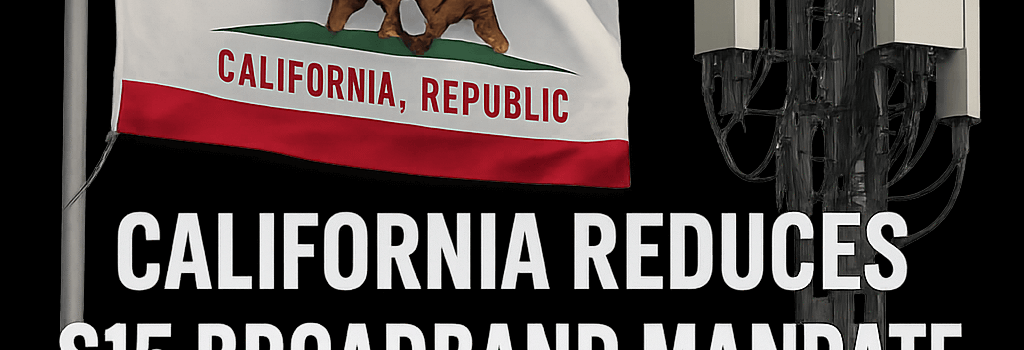California Reduces $15 Broadband Mandate Amid Federal Pressure

After months of legislative debate and negotiations, California legislators have suspended their effort to require Internet Service Providers (ISPs) to offer a $15-per-month broadband tier for low-income residents. The decision comes in response to new guidance from the National Telecommunications and Information Administration (NTIA) threatening to withhold the state’s $1.86 billion share of the BEAD (Broadband Equity, Access, and Deployment) funding if California proceeded with explicit rate controls.
Background: The AB 353 Proposal
Assemblymember Tasha Boerner (D-77th District), chair of the Communications and Conveyance Committee, introduced AB 353 in early 2025, modeled on New York’s affordability law. Key provisions included:
- Low-Cost Service Option (LCSO): A mandatory $15/month broadband package.
- Speed Requirements: Initially set at 100/20 Mbps (down/upload), later reduced to 50/10 Mbps after ISP negotiations.
- Eligibility Verification: Proposed to be managed by ISPs rather than the California Public Utilities Commission (CPUC).
The intent was to close California’s digital divide by mandating affordable, baseline broadband on existing networks serving urban and rural communities.
NTIA’s Guidance and Federal-State Tension
In July 2025, NTIA officials informed Boerner’s office that states imposing specific rate caps on LCSOs would be disqualified from receiving BEAD grants. According to assembly records:
NTIA stated that “explicit or implicit rate regulation” by subgrantees violates the BEAD Notice of Funding Opportunity, thereby risking California’s allocation of federal dollars for broadband expansion.
Under Section 60102(c) of the Infrastructure Investment and Jobs Act, subgrantees must offer a “low-cost broadband service option,” but NTIA’s latest program guidance clarifies that states may not mandate a specific rate.
Key Technical Implications
Network Infrastructure Requirements
To support a 50/10 Mbps LCSO, ISPs generally rely on one of two network architectures:
- DOCSIS 3.1 (Cable): Utilizes existing coaxial cable plants with fiber-fed nodes; supports up to 1 Gbps down/upstream when upgraded to DOCSIS 4.0 but often limited to 100/20 Mbps tiers today.
- FTTx (Fiber-to-the-Home): Provides symmetrical speeds exceeding 1 Gbps; capital costs average $25,000–$30,000 per mile in urban areas and $40,000–$50,000 per mile in rural regions.
Industry analysts estimate that offering a subsidized 50/10 Mbps plan could reduce ARPU (average revenue per user) by over 60% compared to legacy 100/20 Mbps packages, impacting network ROI unless offset by BEAD infrastructure grants.
Verification & Privacy Concerns
The draft AB 353 would have allowed ISPs to verify subscriber eligibility by cross-referencing Lifeline or SNAP databases. Digital equity advocates warned:
ISP-based verification creates a chilling effect among immigrant communities and privacy-conscious users, who fear data sharing with federal agencies.
By contrast, the CPUC’s existing Lifeline enrollment system leverages a state-authorized Secure Data Exchange Hub to protect Personally Identifiable Information (PII) under California Consumer Privacy Act (CCPA) guidelines.
Legal Precedents & Regulatory Landscape
New York’s low-cost broadband law survived challenges in the Second Circuit (NYPBA v. New York PSC, 2023) and saw two Supreme Court refusals to hear appeals. However, the Biden Administration—through NTIA—has increasingly sided with industry on BEAD compliance, creating friction with state-level affordability mandates.
Legal scholars note that while federal statutes establish BEAD criteria, they do not explicitly preempt state rate-setting authority. Professor Carol Rose of Stanford Law observes:
“The NTIA’s interpretation stretches the Supremacy Clause, potentially chilling state innovation on digital equity and widening the gap between Federal intent and local needs.”
Digital Equity & Future Policy Directions
California advocates have called on legislators to pursue alternative measures:
- Expand state-funded voucher programs to subsidize privately offered $30–$40 packages.
- Encourage smaller ISPs and municipal networks to pilot community-driven affordability models exempt from BEAD restrictions.
- Lobby Congress to reinstate or expand the national Affordable Connectivity Program (ACP), which provided $30/month discounts until its sunset in late 2024.
Network Economics & Industry Perspectives
Broadband consultancy TeleTriad recently analyzed California’s top four providers—AT&T, Comcast, Charter, and Cox—and estimated:
“A mandatory $15 LCSO at 50/10 Mbps would reduce combined broadband revenue by 0.7% annually, while generating minimal incremental network congestion due to low subscriber uptake.”
Charter Communications signaled openness to voluntary low-cost tiers if paired with targeted subsidies and relaxed franchise fee obligations.
Additional Sections for Deeper Analysis
1. Technical Roadblocks for Rural Deployments
In sparsely populated counties, last-mile fiber deployment faces right-of-way challenges and elevated per-subscriber costs. Innovative wireless solutions—licensed point-to-multipoint (P2MP) in the 3.5 GHz CBRS band and 5G mmWave—could deliver 100/20 Mbps with lower capex, but spectrum licensing and backhaul remain hurdles.
2. Federal-State Funding Synergies—and Conflicts
The BEAD program’s goal of bridging “unserved” areas by 2029 relies on matching state contributions and adherence to buildout milestones. California’s potential refusal of rate control provisions underscores a broader debate: should affordability conditions apply to new builds only, or also to existing commercial offerings?
3. Policy Innovation: Digital Equity Hubs
Several counties, including Santa Clara and Alameda, are piloting Digital Equity Hubs—community centers offering subsidized connectivity, device loans, and literacy training. Early results show a 25% increase in enrollment when wraparound services accompany low-cost plans.
Looking Ahead
With AB 353 held in committee, California lawmakers and stakeholders are exploring hybrid approaches that balance affordability, network sustainability, and federal compliance. As NTIA finalizes its BEAD rulemaking in late 2025, state and industry leaders will weigh collaboration versus litigation to define America’s broadband future.